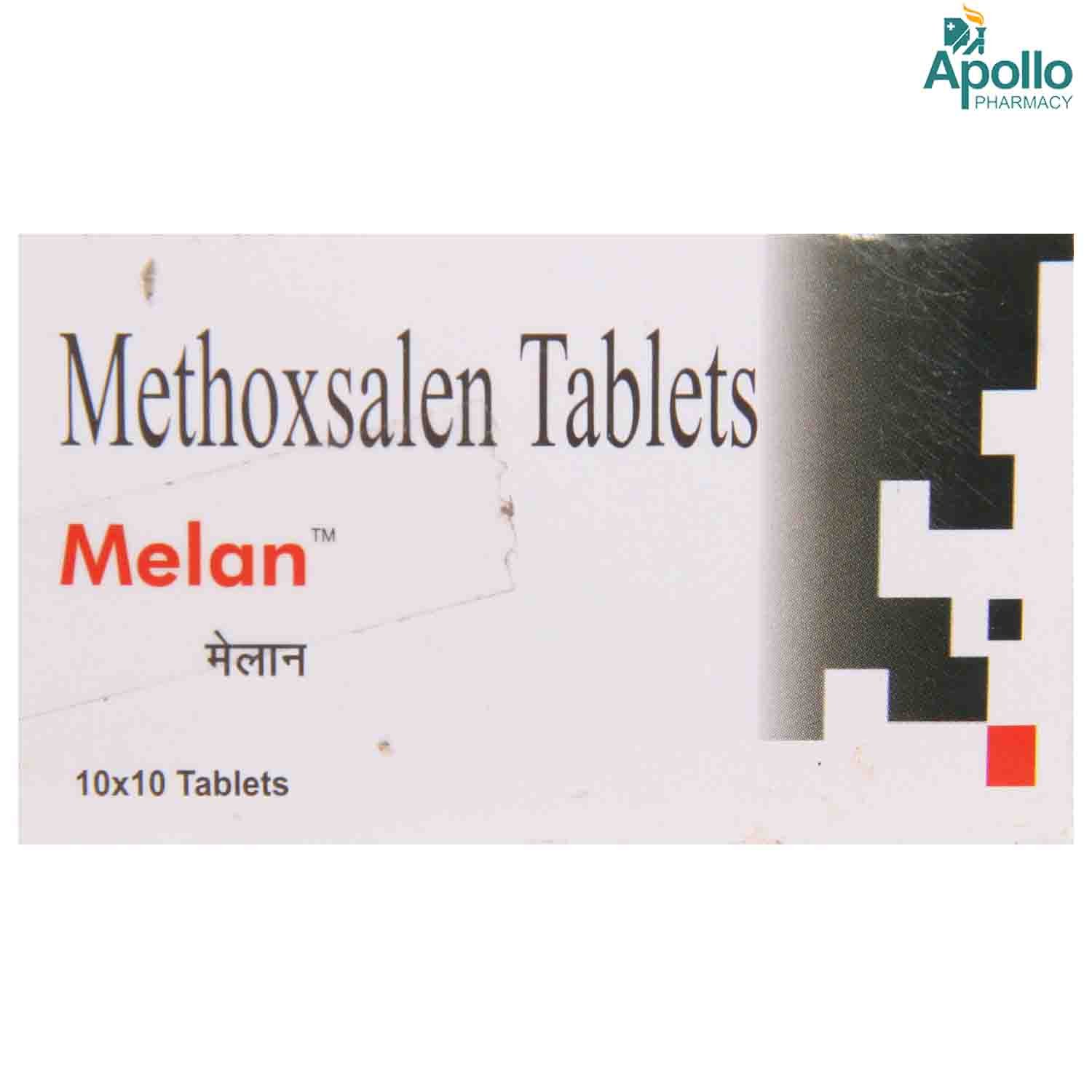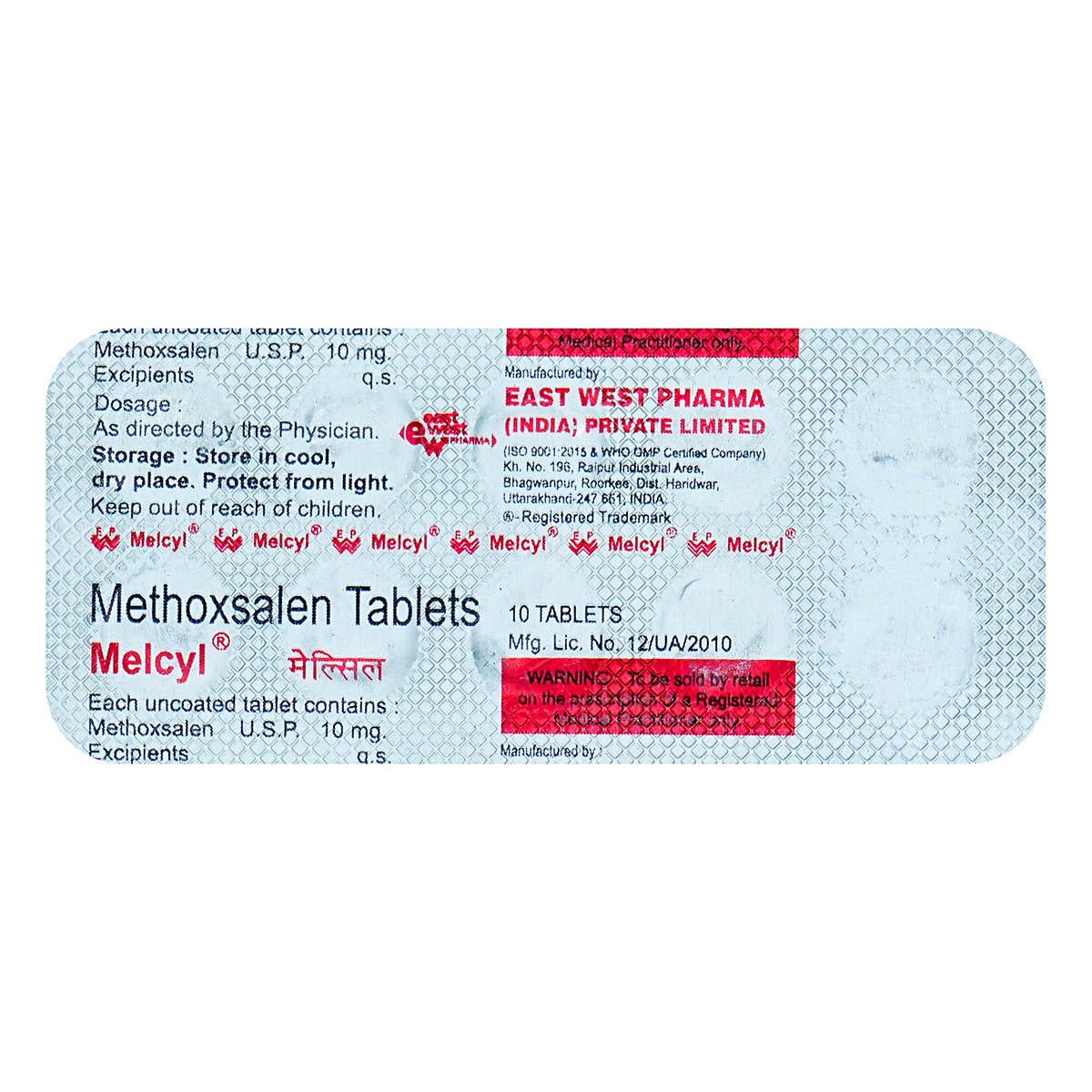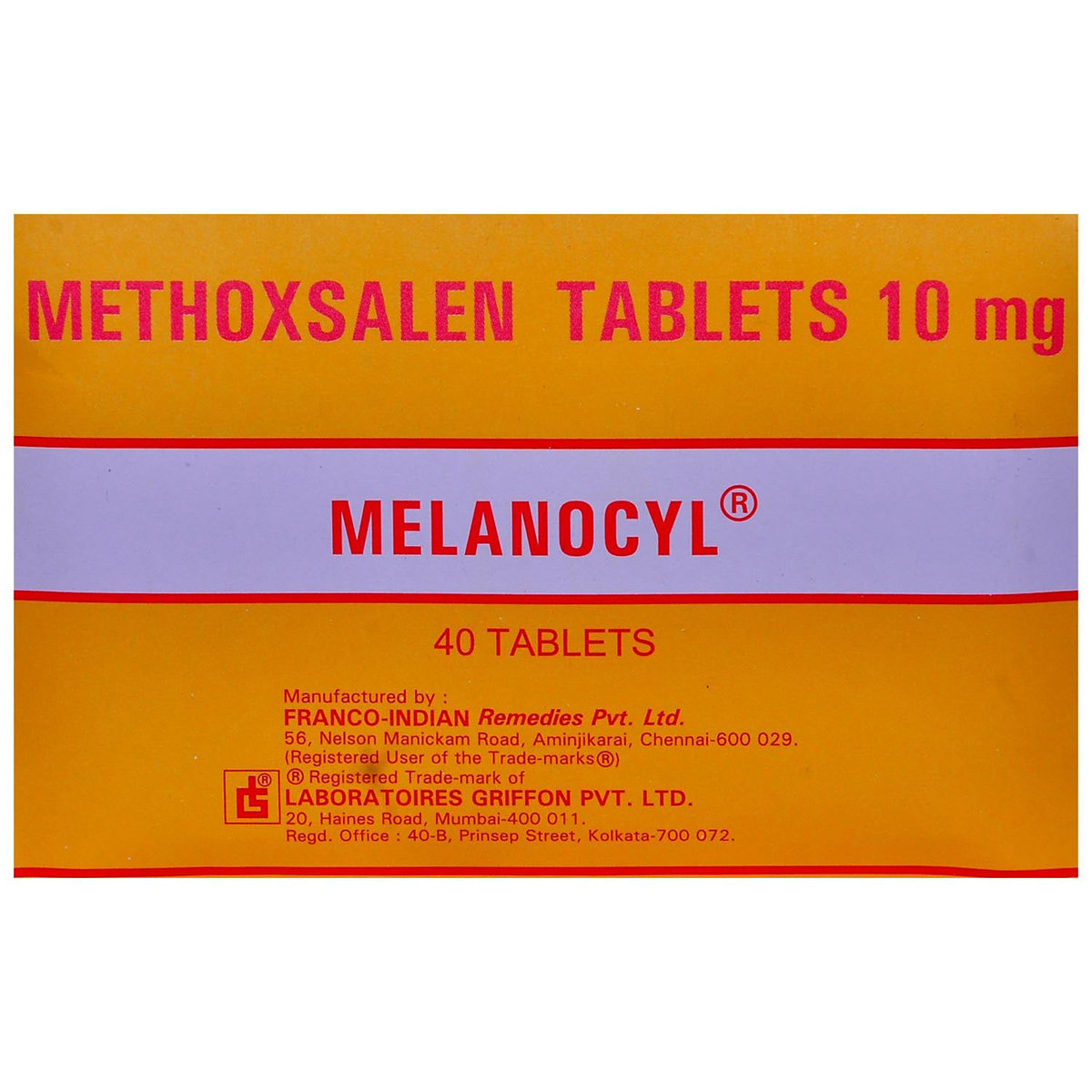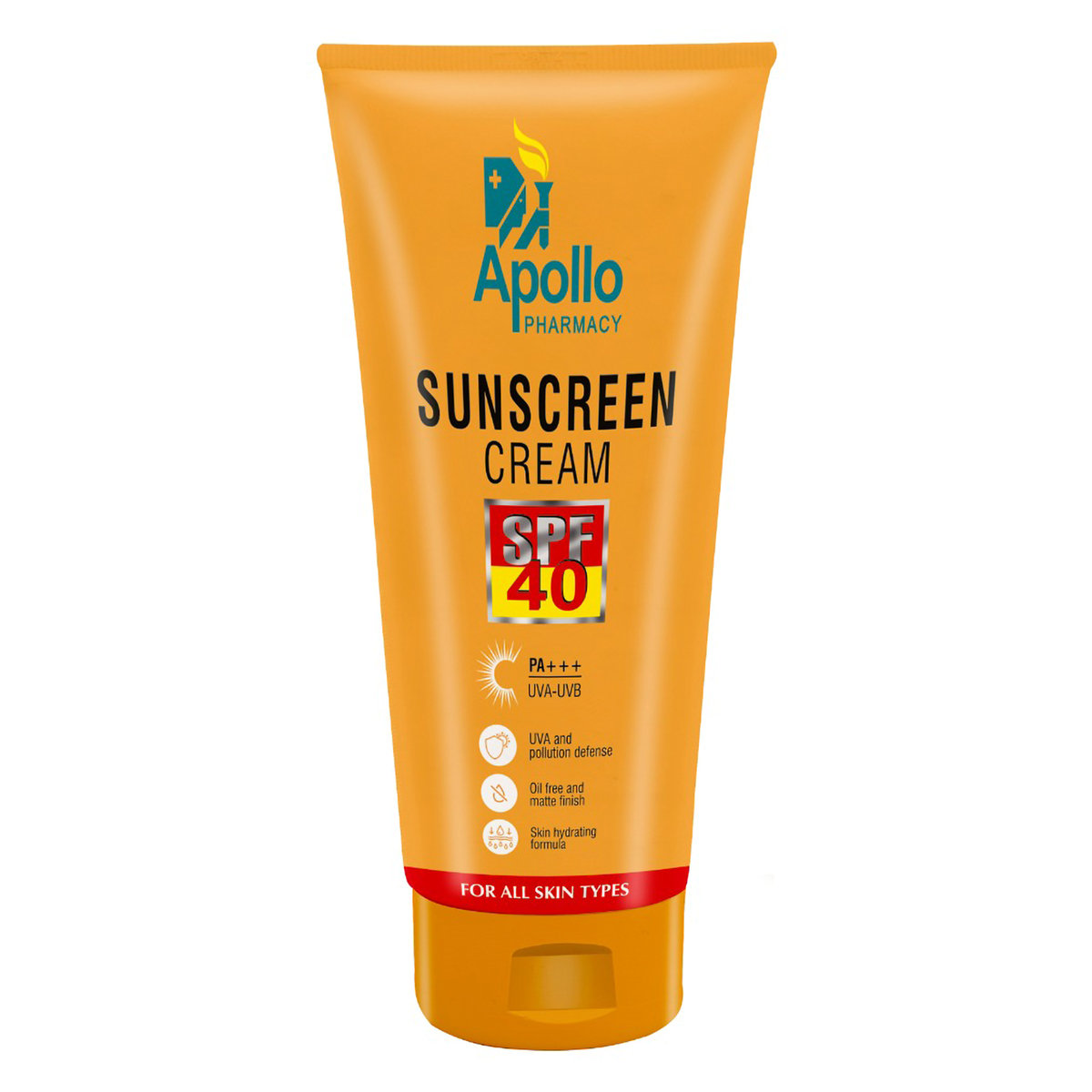Meladerm 10 mg Tablet


MRP ₹93
(Inclusive of all Taxes)
₹13.9 Cashback (15%)
know your delivery time
Provide Delivery Location
Composition :
Manufacturer/Marketer :
Consume Type :
Expires on or after :
Return Policy :

Secure Payment

Trusted by 8 Crore Indians

Genuine Products
Therapeutic Class
Country of origin
Manufacturer/Marketer address
Disclaimer
Alcohol
Safe if prescribed
You are recommended not to consume alcohol along with Meladerm 10 mg Tablet to avoid unpleasant side effects. Alcohol can make you dizzier.
Pregnancy
Consult your doctor
It is not known whether Meladerm 10 mg Tablet taken orally will harm an unborn baby. Inform your doctor if you are pregnant or plan to become pregnant.
Breast Feeding
Consult your doctor
It is not safe to use Meladerm 10 mg Tablet for breastfeeding mothers. Always ask your doctor because it causes risks to the baby.
Driving
Safe if prescribed
Meladerm 10 mg Tablet usually causes dizziness and affects driving ability. Do not drive, use machinery, or do anything that requires alertness until you can do it safely.
Liver
Consult your doctor
Meladerm 10 mg Tablet to be taken with caution, especially if you have a history of liver diseases/conditions. The dose may have to be adjusted by your doctor.
Kidney
Consult your doctor
Meladerm 10 mg Tablet to be taken with caution, especially if you have a history of kidney diseases/conditions. The dose may have to be adjusted by your doctor.
Children
Safe if prescribed
This Meladerm 10 mg Tablet is not recommended for children below 12 years. Therefore, it is not safe for children.
Product Substitutes
About Meladerm 10 mg Tablet
Meladerm 10 mg Tablet belongs to the class of medicines called psoralens primarily used to treat psoriasis (scaly, itchy, and red patches on the skin), or vitiligo (discoloured patches in different areas of the body, including the skin, hair). Psoriasis is a chronic, painful, nontransmissible, deactivating and damaging disease. Psoriasis can also be caused by internal and external activates, including sunburn, mild trauma, systemic drugs, infections, and stress. Vitiligo is a disorder in which the skin turns white due to the loss of pigment from the melanocytes, (cells that produce the colour), melanin that gives skin colour.
Meladerm 10 mg Tablet contains methoxsalen, that is used alongside ultraviolet-A radiation. It works by reducing the number of cells the skin makes.
Take Meladerm 10 mg Tablet as prescribed by your doctor. You are advised to take Meladerm 10 mg Tablet for as long as your doctor has prescribed it for you depending on your medical conditions. You may experience erythema (skin redness), oedema (swelling), blisters on the skin, and itching. Most of these side effects of Meladerm 10 mg Tablet do not require medical attention and gradually resolve over time. However, if the side effects are persistent, reach out to your doctor.
Before starting Meladerm 10 mg Tablet , please inform your doctor if you have any allergies, history of skin cancer, eye disorder, heart disease, liver disease, kidney disease, or skin pigment disorder. Immediately contact your doctor if you are pregnant or plan to become pregnant, and breastfeeding.
Uses of Meladerm 10 mg Tablet
Medicinal Benefits Mweb
Key Benefits
Meladerm 10 mg Tablet contains methoxsalen, which is a local acting drug. It is primarily used in the treatment of psoriasis (scaly, itchy, and red patches on the skin), or vitiligo (discoloured patches in different areas of the body, including the skin, hair). Meladerm 10 mg Tablet is an organic compound and a local acting drug. It is used alongside ultraviolet-A radiation. It works by reducing the number of cells the skin makes.
Directions for Use
Side Effects of Meladerm 10 mg Tablet
- Erythema (skin redness)
- Oedema (swelling)
- Blisters on the skin
- Itching
Drug Warnings
Inform your doctor before using Meladerm 10 mg Tablet , if you have previously had an allergic reaction (hypersensitivity). Before starting Meladerm 10 mg Tablet , please inform your doctor if you have any history of skin cancer, eye disorder, heart disease, liver disease, kidney disease, or skin pigment disorder. Immediately contact your doctor if you are pregnant or plan to become pregnant, and breastfeeding. If there is an overdose, you may be trained to stay in a dark room for 24 hours and make yourself vomit.
Drug-Drug Interactions
Drug-Drug Interactions
Login/Sign Up
Taking rasagiline with Meladerm 10 mg Tablet may increases the blood levels of rasagiline.
How to manage the interaction:
Although there is an interaction between Meladerm 10 mg Tablet and rasagiline, it can be taken if your doctor has advised it. However, if you experience drowsiness, dizziness, lightheadedness, blood pressure changes, nausea, vomiting, or hallucinations (seeing or hearing things that do not exist) contact a doctor immediately. Do not discontinue any medications without a doctor's advice.
Co-administration of Aminolevulinic acid and Meladerm 10 mg Tablet together can increase the risk of sunburn.
How to manage the interaction:
Co-administration of Meladerm 10 mg Tablet with Aminolevulinic acid can possibly result in an interaction, but it can be taken if a doctor has advised it. If you notice that your skin is very sensitive to sunlight or if you have a really bad sunburn, it's important to contact a doctor right away. Following treatment, you should avoid exposure of the eyes and skin to sunlight or bright indoor lights for 48 hours. Do not stop using any medications without talking to a doctor.
Taking Tizanidine with Meladerm 10 mg Tablet may increase the risk of severe side effects.
How to manage the interaction:
Co-administration of Tizanidine with Meladerm 10 mg Tablet can possibly result in an interaction, but it can be taken if your doctor has advised it. However, consult your doctor immediately if you experience symptoms such as drowsiness, dizziness, lightheadedness, fainting, and irregular heart rhythm. Do not stop using any medications without a doctor's advice.
Drug-Food Interactions
Drug-Food Interactions
Login/Sign Up
Drug-Diseases Interactions
Drug-Diseases Interactions
Login/Sign Up
Drug-Drug Interactions Checker List
- CIPROFLOXACIN
- HYDROCHLOROTHIAZIDE
- LOPINAVIR
- RITONAVIR
Habit Forming
Special Advise
- You will need to have an eye check-up before starting Meladerm 10 mg Tablet and also once a year afterwards.
- Avoid sunlight on your lips or skin for at least 8 hours after taking Meladerm 10 mg Tablet .
Diet & Lifestyle Advise
- Avoid sunlight exposure for 24 hours before taking Meladerm 10 mg Tablet . Wear UVA-absorbing, and cover exposed skin, wrap-around sunglasses, or use sunblock for the twenty-four-hour period after treatment with Meladerm 10 mg Tablet .
- Use extra caution for at least 48 hours after each treatment. Cover your skin for at least 8 hours by wearing protective clothing after each treatment,
- Do not increase the quantity of Meladerm 10 mg Tablet if you are taking or use additional time under an ultraviolet lamp or in the sunlight.
All Substitutes & Brand Comparisons
RX
Out of StockDlen 10mg Tablet
Bonsai Pharma
₹20
(₹1.8 per unit)
35% CHEAPERRX
Out of StockKuvadex 10mg Tablet
Kivi Labs Ltd
₹24.05
(₹2.16 per unit)
22% CHEAPERRX
MELAN 10MG TABLET
Med Manor Organics Pvt Ltd
₹25
(₹2.25 per unit)
19% CHEAPER

Have a query?
Buy best Dermatology products by
Glenmark Pharmaceuticals Ltd
Sun Pharmaceutical Industries Ltd
Klm Laboratories Pvt Ltd
Cipla Ltd
Canixa Life Sciences Pvt Ltd
Abbott India Ltd
Ajanta Pharma Ltd
Intas Pharmaceuticals Ltd
Dr Reddy's Laboratories Ltd
East West Pharma India Pvt Ltd
Alkem Laboratories Ltd
Atopic laboratories Pvt Ltd
Hegde & Hegde Pharmaceutica Llp
Brinton Pharmaceuticals Ltd
Torrent Pharmaceuticals Ltd
Amwill Healthcare Pvt Ltd
Leeford Healthcare Ltd
Palsons Derma Pvt Ltd
Oaknet Healthcare Pvt Ltd
Med Manor Organics Pvt Ltd
Micro Labs Ltd
Dermocare Laboratories Gujarat Llp
Fixderma India Pvt Ltd
Apex Laboratories Pvt Ltd
Mankind Pharma Pvt Ltd
Ipca Laboratories Ltd
Yaher Pharma
Systopic Laboratories Pvt Ltd
Menarini India Pvt Ltd
Ethinext Pharma
Nemus Pharmaceuticals Pvt Ltd
Skinocean Pharmaceuticals
Dermacia Healthcare
Inex Medicaments Pvt Ltd
Lupin Ltd
GlaxoSmithKline Pharmaceuticals Ltd
Talent India Pvt Ltd
Zydus Cadila
Kivi Labs Ltd
Zydus Healthcare Ltd
Hbc Dermiza Healthcare Pvt Ltd
Mrhm Pharma Pvt Ltd
Regaliz Medicare Ltd
Sol Derma Pharmaceuticals Pvt Ltd
Newtrimed Healthcare Pvt Ltd
Wallace Pharmaceuticals Pvt Ltd
Eskon Pharma
Glowderma Lab Pvt Ltd
La Pristine Bioceuticals Pvt Ltd
Mohrish Pharmaceuticals Pvt Ltd
Percos India Pvt Ltd
Rockmed Pharma Pvt Ltd
Macleods Pharmaceuticals Ltd
Praise Pharma
Ethicare Remedies Pvt Ltd
Kaizen Drugs Pvt Ltd
Aurel Biolife
Rely On Pharmaceuticals
Wockhardt Ltd
Galcare Pharmaceuticals Pvt Ltd
Elder Pharmaceuticals Ltd
Indiabulls Pharmaceuticals Pvt Ltd
La Med Healthcare Pvt Ltd
Biocute Life Care
Yap Bioceuticals
Yash Pharma Laboratories Pvt Ltd
Zee Laboratories Ltd
Apple Therapeutics Pvt Ltd
Adonis Laboratories Pvt Ltd
Albatross Healthcare Pvt Ltd
Galderma India Pvt Ltd
Prism Life Sciences Ltd
FDC Ltd
Alniche Life Sciences Pvt Ltd
Salve Pharmaceuticals Pvt Ltd
West Coast Pharmaceuticals Pvt Ltd
Dermarex HealthCare India Pvt Ltd
Arka Vital Science Pvt Ltd
Dermajoint India
Gary Pharmaceuticals Pvt Ltd
Grace Derma Healthcare Pvt Ltd
Karlin Pharmaceuticals & Exports Pvt Ltd
Skinska Pharmaceutica Pvt Ltd
Uniza Healthcare Llp
Alembic Pharmaceuticals Ltd
Cadila Healthcare Ltd
Cadila Pharmaceuticals Ltd
Cosmofix Technovation Pvt Ltd
Human Pharmaceuticals
Indolands Pharma Pvt Ltd
Lyra Laboratories Pvt Ltd
Akumentis Healthcare Ltd
Entod Pharmaceuticals Ltd
Iceberg Health Care Pvt Ltd
Jenburkt Pharmaceuticals Ltd
P and P Dermaceuticals Pvt Ltd
Dabur India Ltd
Indchemie Health Specialities Pvt Ltd
Olcare Laboratories Pvt Ltd
Unison Pharmaceuticals Pvt Ltd
BODY CREAM
Body Lotion
Face Cream
Shampoo
Sun Screen
Face Gel
Soap
Face Wash
HAIR SOLUTION
Face Serum
BODY GEL
Hair Lotion
Hair Serum
Dusting Powder
ANTISEPTIC
FACE CLEANSER
Face Lotion
Body Wash
Body Spray
Eye Cream
FUNGAL INFECTION
Foot Cream
Conditioner
Eye Gel
Cleanser
Hair Cream
Hair Oil
Face Mask
Hair Gel
Sanitizer
Hair Spray
Moisturiser
Skin Ointment
Lip Balm
Capsule
Eye Serum
Intimate Wash
Specialty Supplements
Hand Cream
Facial Spray
SPECIALITY SUPPLEMENT
Face Toner
MEDICATED SHAMPOO
Tablet
Talcum Powder
BABY SUNSCREEN
Body Butter
Body Scrub
DIAPER RASH CREAM
EYE SOLUTION
FACIAL WIPE
Gargle
Hand Wash
Intimate Spray
Lip Serum
Lubricant Gel
MEDICATED CREAM
Nail Polish
VITAMIN D
Customers Also Bought








